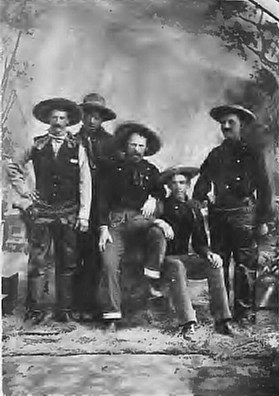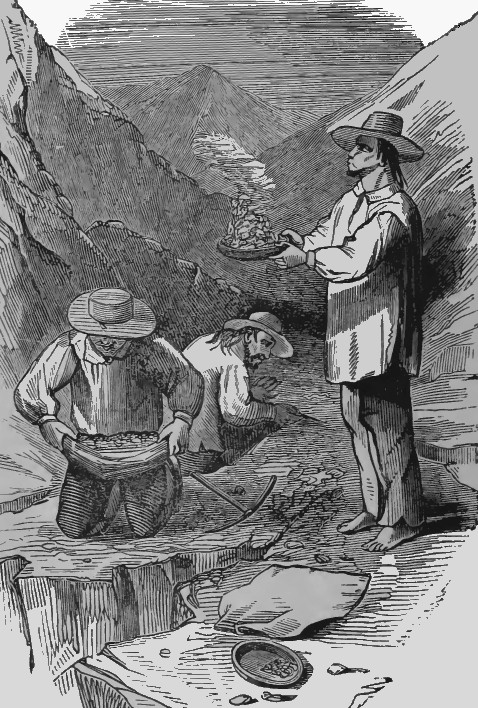RAY CONSOLIDATED
While the Ray Consolidated is eleventh on the State's list of dividend
producers, the daily output of ore from its mines is greater than any of its
rivals, amounting to 9,000 tons a day. The property is located on Mineral
Creek in Pinal County, so named by Lieut. W.
Emory who was with General Kearny's dragoons on their passage to California
in 1846. Although Emory's report gave enthusiastic predictions concerning
the noticeable copper croppings at the mouth of the stream, no locations
were made in the district until about 1874. Three years later the Mineral
Creek Mining district had been formed and was favorably known, not for
copper however, but as the location of several promising
silver claims.
In 1883, a thirty-ton furnace was treating ore from the Ray, Scorpion and Bilk mines. Soon after that the Ray Copper Company, which was organized in 1882, erected a small concentrating mill and remodeled its furnace. The company, in 1898, sold its holdings to a syndicate of Englishmen whose principal was James Gordon. The Ray Copper Company, Ltd., was organized by them and a mill was built at what is now Kelvin, where Mineral Creek empties into the Gila, and a railroad was constructed from there to the mine. It would seem that the-investment did not prove a profitable one and the property passed into the hands of the Guggenheimer organization in 1908. Under the efficient administration of D. C. Jackling, the present vice-president and manager, the ore is now being handled in the most approved scientific manner, and the property is on a sound financial basis. The Ray Mill was erected at Hayden in 1910, and in 1912 the company built, on adjoining ground, one of the greatest smelters in the State, equipped with reverberatory furnaces. With its immense deposit of low grade ore, estimated the third largest in the United States, its future may be said to be more like that of a manufacturing problem than the usual mine. It is simply a question of manufacturing the ore now blocked out into copper. The company is working about 2,100 men.
INSPIRATION
Though not among the present "Big Eleven" dividend producers, The
Inspiration Consolidated Copper Company mine is among the notable properties
of the State. In the first place it has the privilege of paying taxes on the
greatest assessed value (over $74,000,000) of any of Arizona's mines; and
secondly, what probably pleases its stockholders more, it is said that in
capacity of mill and mine operation, it leads the State. To put it on its
present standing of efficiency $15,000,000 was spent in development work and
in creating the various plants required for its successful operation. The
ore varies in width in Inspiration ground from 200 to 1,600 feet, with an
average vertical dimension approximating 150 feet. The daily average amount
of ore ground at the Marcey Mill is 475 tons, and the company employs about
625 men.
AJO MINES
It is interesting to note that the old Ajo mines, the first copper
properties to be worked within the State, and for a generation practically
lying idle, have been reborn by modern scientific methods, and now, held by
a subsidiary company under the Calumet and Arizona, are considered among
the big coming properties in the State. The presence of a large body of low
grade
copper ore has, for many years, been known to exist at Ajo, but it
was thought that the grade was so low, less than two per cent, that it would
not pay to work it. However, under Maj. John C. Greenway, the manager of the
Calumet and Arizona Mining Company, in 1915, a long series of experiments were
carried on until a process had been satisfactorily developed, complete in
every detail. The process was finally
decided upon January 10, 1916, the ground broken February 1, 1917, and a
5,000-ton plant for handling the ore completed May, 1917.
To the New Cornelia, the original purchase of the Calumet and Arizona, in August of 1917 was added the ground of the Ajo Consolidated Copper Company 1,150 acres. With the ore now developed in the New Cornelia and these new lands there are about 65,000,000 tons of ore in sight. Announcement that the New Cornelia will erect a 5,000-ton flotation plant and a 2,000-ton smelter at Ajo is said to have been made by the C. & A. management. While the principal metals found in Arizona are copper, silver, gold, lead and zinc, most of the other rarer metals also are found. The molybdenum ores, namely molybdenite and wulfenite, are found in many places in Arizona. Molybdenite is found in Gila County in disseminated ores at Miami; in Greenlee County in the copper ores of the Clifton-Morenci district; in Pinal County in ores at Ray and Kelvin as original mineral. It is also found in Pima and Santa Cruz counties.
Wulfenite is nearly always present in silver ores at Tombstone; it is also found in Cochise, Gila and Pima, Pinal, Yavapai and Yuma counties. Molybdenite, used extensively in the manufacture of exceedingly hard steels, is peculiarly adapted for armor plate. When a regular supply can be guaranteed to steel manufacturers, there is no doubt of a steady market for Arizona's ample supply of molybdenite. Vanadium ore is well scattered throughout the State, principally as the mineral, vanadinite. It is found in Cochise County, near Fairbanks; in Gila County in the Globe district; in Pima County 14 miles northwest of Tucson, and in several places in Pinal and Yavapai counties. Tungsten ore is also found in many parts of Arizona, including Pima, Santa Cruz, Cochise, Maricopa, Mojave and Yavapai counties. Manganese is also found in many places in the State. Mercury is found in Maricopa, Yavapai and Gila counties.Building materials of a varied character are found within the State, including cement rock, lime, gypsum, marble and slate. Arizona promises future development in asbestos, mica, celestite and strontianite which are used for fireworks, barites, clays and other products.
In addition to this it must be remembered that most of the mines listed as copper also carry native gold and silver, and that many new mines have been put in operation since the directory was compiled. Zinc is now fifth or sixth on the list of metals produced in the State, but is quite likely to become second only to copper in importance owing to the exceedingly large deposits of zinc carbonates which have recently been discovered. In general it may be said that Arizona miners receive in wages every year over $50,000,000. The eleven big copper companies paid in dividends in 1916 (estimated) $35,000,000. The total production of gold, silver and copper in Arizona for 1916-1917 is as follows : 1916, gold, $4,092,800; silver, 6,680,252 fine ounces; copper, 692,630,286 pounds. In 1917, gold, $5,533,800; silver, 8,183,205 ounces; copper, 692,923,722 pounds. In money the total valuation of all mineral production in Arizona in 1916 was about $205,000,000, and in 1917, in spite of labor difficulties and the fixation of the price of some minerals, it rose to about $225,000,000. The assessed valuation on Arizona mines, mills and smelters for 1918 aggregated over $421,000,000. In speaking of the probable prospects for the year 1918, G. M. Butler, acting director of the Arizona State Bureau of Mines, says:
"It is rather early in the year to attempt to prophesy anything as to the production for 1918. So many unforeseen factors enter into the matter that at best it can be nothing but a rough guess. The Government's refusal to raise the price of copper has done much to discourage small producers, many of whom were working at a loss in hope that the Government would do something to alleviate their difficulties. Doubtless a considerable number of these will be forced to stop work. The low price of copper also prevents the larger mining companies from doing much needed development work, and that is bound to have an unfortunate effect upon their production, which will become more and more evident as time goes on. The market for tungsten, molybdenum, and other relatively rare metals used in ferro-alloys is in a very unstable condition at present, and offers little incentive to producers of these metals. Whether any change may be expected in the near future it is now impossible to say. "On the other hand labor troubles considerably curtailed the possible production of Arizona mines last year, and, if this year can be passed through without a repetition of these difficulties, this factor may counterbalance the detrimental ones already cited. Taking everything into consideration, I believe that our production this year will be about equal to that of last year unless difficulties now unforeseen arise; and there seems little doubt that Arizona will retain her place as the first mineral state in the Union."
Return
to The Arizona Page:
Arizona Gold Rush Mining History



